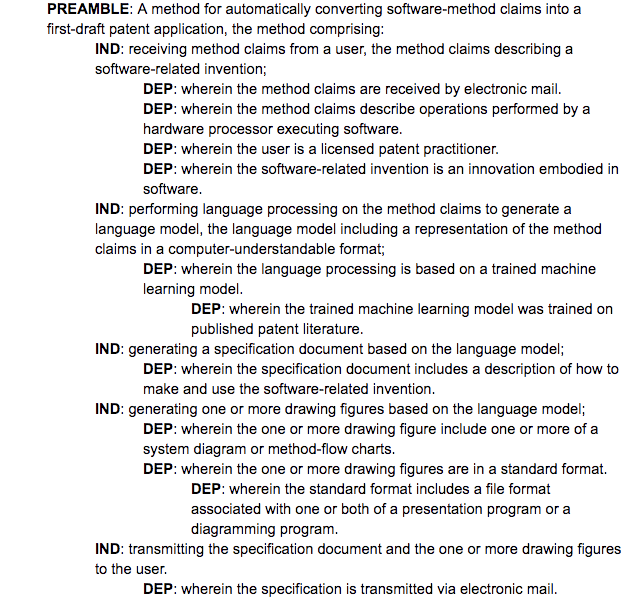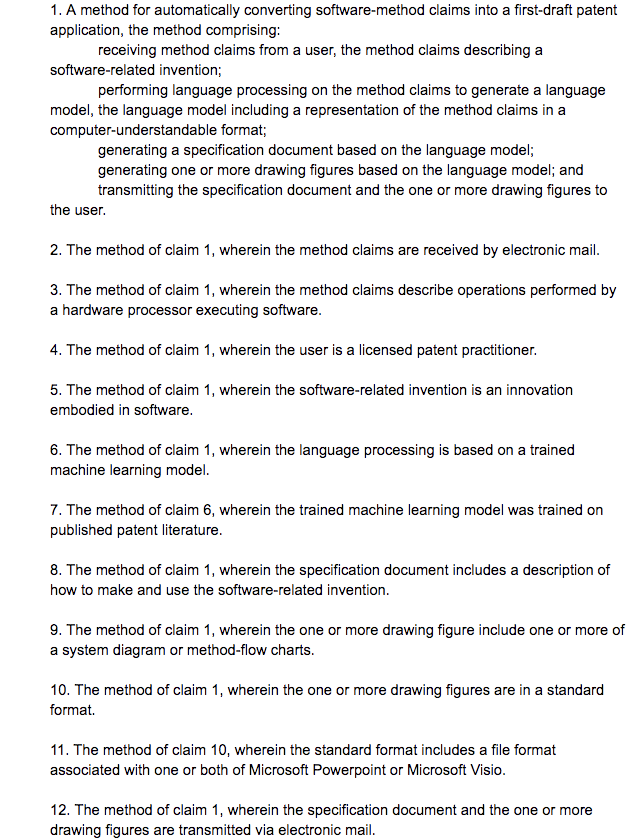By Ian C. Schick, PhD, JD, CEO & Co-founder of Specifio (originally posted here on Sept. 17, 2018)
Patent application drafting is an art form. Or at least parts of it are. Take claims for example. Some describe claims drafting as a cross between writing computer code and poetry. There’s certainly a significant aspect that is syntax driven, but the rest can be very nuanced being driven largely by creativity and judgment. A rule of thumb is that it takes around four years of apprenticeship for a practitioner to gain a solid command of claims drafting.
To craft commercially-valuable claims, the practitioner must have a firm grasp of the invention, requiring technical expertise in the area. But that’s not the end of it. Patent law is constantly evolving, so precedent is also a major factor in developing claims, which is where legal expertise then comes into play. The practitioner must have a sense for things like the client’s business and how the invention fits into their business strategy. There can be many other factors considered by the practitioner when writing claims.
The claims define the legal right being sought during prosecution and, as such, are by far the most important part of a patent application. Great claims, however, can fall flat if they are not sufficiently supported by the specification. MPEP 608 provides:
To obtain a valid patent, a patent application as filed must contain a full and clear disclosure of the invention in the manner prescribed by 35 U.S.C. 112(a). The requirement for an adequate disclosure ensures that the public receives something in return for the exclusionary rights that are granted to the inventor by a patent.
Section 112(a) states:
The specification shall contain a written description of the invention, and of the manner and process of making and using it, in such full, clear, concise, and exact terms as to enable any person skilled in the art to which it pertains, or with which it is most nearly connected, to make and use the same, and shall set forth the best mode contemplated by the inventor or joint inventor of carrying out the invention.
Not all, but much of the process for preparing a specification that meets the Section 112 standard is more mechanical-writing in nature and, therefore, is ripe for automation. Below, we’ve laid out the steps practitioners can follow to leverage Specifio’s automated patent drafting service to minimize drafting time without diluting quality or the unique impact skilled practitioners bring to the work product.
Step Zero: The Doc Plan
It all starts with a solid Doc Plan. This is what controls the appearance, content, and structure of the auto-drafts generated by Specifio. In addition to stylistic preferences, a practitioner will want to build in any contextual-but-non-invention-specific material. Traditionally, this might include template language and stock figures, which can all be incorporated into a Doc Plan. Once a Doc Plan is designed, it’s kind of like “set-it-and-forget-it.” So, this part doesn’t count toward the five hours.
Step One: The Pre-App
A pre-app is a technique for rapidly developing content for claims. It’s a way to outline an invention using claim-style language, but in a more intuitive and easy-to-follow format than starting with the claims themselves.
Here is a simple example for creating a pre-app covering a software-related invention:
First, identify the main thrust of the invention and write it out in this form:

Second, think of the main steps the software performs, and write them out like this:

Finally, flesh out the concepts in the IND lines and use indentation to keep track of dependency:

Step Two: The Claims
Once the pre-app is complete, it needs to be converted to normal claim format. Copy the PREAMBLE and IND lines to create the independent claim. Add numbers and preambles to the DEP lines to create the dependent claims. And you’re done with the claims!

Step Three: The Auto-Draft
This is the best part. Simply put the claims into a Microsoft Word document and send them to Specifio. In only a couple minutes, you’ll receive a first draft application complete with basic figures. Two or three pages of claims (almost) instantly becomes a 20–30 page first draft.
Step Four: Bolster and Finalize for Filing
Once the auto-generated first-draft patent application is received from Specifio, it’s time to add in descriptions of specific examples, flesh out key terms and concepts, and add in descriptions of any additional invention-specific figures. After that, the application should be done and ready to file.
For more information on Specifio’s automated patent drafting service, visit our website or email us at info@specif.io.
DISCLAIMER: The views and opinions expressed in this article are those of the author and (1) are not provided in the course of and do not create or constitute an attorney-client relationship, (2) are not intended as a solicitation, (3) are not intended to convey or constitute legal advice, and (4) are not a substitute for obtaining legal advice from a qualified attorney. You should not act upon any such information without first seeking qualified professional counsel on your specific matter. The hiring of an attorney is an important decision that should not be based solely upon Web site communications or advertisements.
